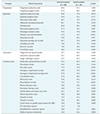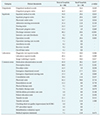1. Jha AK, DesRoches CM, Campbell EG, Donelan K, Rao SR, Ferris TG, et al. Use of electronic health records in U.S. hospitals. N Engl J Med. 2009; 360(16):1628–1638.

2. Holroyd-Leduc JM, Lorenzetti D, Straus SE, Sykes L, Quan H. The impact of the electronic medical record on structure, process, and outcomes within primary care: a systematic review of the evidence. J Am Med Inform Assoc. 2011; 18(6):732–737.

3. Park YT, Han D. Current status of electronic medical record systems in hospitals and clinics in Korea. Healthc Inform Res. 2017; 23(3):189–198.

5. Shachak A, Reis S. The impact of electronic medical records on patient-doctor communication during consultation: a narrative literature review. J Eval Clin Pract. 2009; 15(4):641–649.

7. Osheroff JA, Teich JM, Middleton B, Steen EB, Wright A, Detmer DE. A roadmap for national action on clinical decision support. J Am Med Inform Assoc. 2007; 14(2):141–145.

8. Middleton B, Bloomrosen M, Dente MA, Hashmat B, Koppel R, Overhage JM, et al. Enhancing patient safety and quality of care by improving the usability of electronic health record systems: recommendations from AMIA. J Am Med Inform Assoc. 2013; 20(e1):e2–e8.

9. Keenan GM, Lopez KD, Yao Y, Sousa VE, Stifter J, Febretti A, et al. Toward meaningful care plan clinical decision support: feasibility and effects of a simulated pilot study. Nurs Res. 2017; 66(5):388–398.
10. Park H, Lee SI, Hwang H, Kim Y, Heo EY, Kim JW, et al. Can a health information exchange save healthcare costs? Evidence from a pilot program in South Korea. Int J Med Inform. 2015; 84(9):658–666.

11. Khairat S, Marc D, Crosby W, Al Sanousi A. Reasons for physicians not adopting clinical decision support systems: critical analysis. JMIR Med Inform. 2018; 6(2):e24.

12. Thanathornwong B. Bayesian-based decision support system for assessing the needs for orthodontic treatment. Healthc Inform Res. 2018; 24(1):22–28.

13. Jao CS, Hier DB. Clinical decision support systems: an effective pathway to reduce medical errors and improve patient safety. In : Jao C, editor. Decision support systems. London: IntechOpen;2010.
14. Scott IA, Pillans PI, Barras M, Morris C. Using EMR-enabled computerized decision support systems to reduce prescribing of potentially inappropriate medications: a narrative review. Ther Adv Drug Saf. 2018; 9(9):559–573.

15. Adler-Milstein J, Holmgren AJ, Kralovec P, Worzala C, Searcy T, Patel V. Electronic health record adoption in US hospitals: the emergence of a digital “advanced use” divide. J Am Med Inform Assoc. 2017; 24(6):1142–1148.

16. Berner ES, La Lande T. Clinical decision support systems: impacting the future of clinical decision making. In : Ball MJ, Weaver CA, Kiel JM, editors. Healthcare information management systems. New York (NY): Springer;2004. p. 463–477.
17. Institute of Medicine (US) Committee on Data Standards for Patient Safety. Key capabilities of an electronic health record system: letter report. Washington (DC): National Academies Press;2003.
19. Tundia NL, Kelton CM, Cavanaugh TM, Guo JJ, Hanseman DJ, Heaton PC. The effect of electronic medical record system sophistication on preventive healthcare for women. J Am Med Inform Assoc. 2013; 20(2):268–276.

20. Adler-Milstein J, DesRoches CM, Kralovec P, Foster G, Worzala C, Charles D, et al. Electronic health record adoption in US hospitals: progress continues, but challenges persist. Health Aff (Millwood). 2015; 34(12):2174–2180.

21. Kim YG, Jung K, Park YT, Shin D, Cho SY, Yoon D, et al. Rate of electronic health record adoption in South Korea: a nation-wide survey. Int J Med Inform. 2017; 101:100–107.

22. Kharrazi H, Gonzalez CP, Lowe KB, Huerta TR, Ford EW. Forecasting the maturation of electronic health record functions among US hospitals: retrospective analysis and predictive model. J Med Internet Res. 2018; 20(8):e10458.

23. Lee YT, Park YT, Park JS, Yi BK. Association between electronic medical record system adoption and healthcare information technology infrastructure. Healthc Inform Res. 2018; 24(4):327–334.

24. Steiner BA. Electronic medical record implementation in nursing practice: a literature review of the factors of success [dissertation]. Bozeman (MT): College of Nursing, Montana State University;2009.








 PDF
PDF ePub
ePub Citation
Citation Print
Print







 XML Download
XML Download